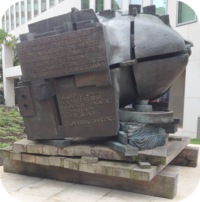Biomimicry: Difference between revisions
From DT Online
mNo edit summary |
(Added Da Vinci quote) |
||
| (4 intermediate revisions by the same user not shown) | |||
| Line 1: | Line 1: | ||
[[File: | [[File:HeadOfInvention.png|right|200px|Paolozzi's Head of Invention|link=https://en.wikipedia.org/wiki/Eduardo_Paolozzi]] | ||
__TOC__ | __TOC__ | ||
''Though human genius in its various inventions with various instruments may answer the same end, it will never find an invention more beautiful or more simple or direct than nature, because in her inventions nothing is lacking and nothing is superfluous.'' | |||
Quote by [https://en.wikipedia.org/wiki/Leonardo_da_Vinci '''Leonardo da Vinci'''] on the base of [https://en.wikipedia.org/wiki/Eduardo_Paolozzi '''Paolozzi's 'Head of Invention''''] sculpture outside the [https://en.wikipedia.org/wiki/Design_Museum '''Design Museum, London''']. | |||
[[File:Ailes battantes Luc Viatour.jpg|right|400px|Ailes battantes Luc Viatour]] | |||
=====Description===== | =====Description===== | ||
| Line 11: | Line 17: | ||
The mathematical biologist D'Arcy Thompson, compares the structural form of the [https://en.wikipedia.org/wiki/Forth_Bridge '''Forth Bridge'''] with the cantilevered skeleton of an ox in his 1917 book | The mathematical biologist [https://en.wikipedia.org/wiki/D%27Arcy_Wentworth_Thompson '''D'Arcy Thompson'''], compares the structural form of the [https://en.wikipedia.org/wiki/Forth_Bridge '''Forth Bridge'''] with the cantilevered skeleton of an ox in his 1917 book '''<dtamazon product="B014GG7CAY" type="text">'On Growth and Form'</dtamazon>''' - a book which argues that it is physics and effects of scale which shape animals and plants. '''Kurt Rowland''' in his book '''<dtamazon product="B0006CU9ZS" type="text">'The Shapes We Need'</dtamazon>''' ''(from the excellent '''<dtamazon product="B0006CU9ZS" type="text">'Looking and Seeing'</dtamazon>''' series)'' showed that bone structures grow to reflect the lines of the forces exerted upon them. It could be argued therefore that [https://en.wikipedia.org/wiki/Biomimetics '''Biomimicry'''] is in some ways a form of [https://en.wikipedia.org/wiki/Reverse_engineering '''Reverse Engineering'''] perhaps? | ||
[[File:VelcroFasteners.png|200px|right|link=http://www.amazon.co.uk/gp/search/ref=as_li_qf_sp_sr_il_tl?ie=UTF8&camp=1634&creative=6738&index=aps&keywords=velcro&linkCode=as2&tag=dton06-21]] | [[File:VelcroFasteners.png|200px|right|link=http://www.amazon.co.uk/gp/search/ref=as_li_qf_sp_sr_il_tl?ie=UTF8&camp=1634&creative=6738&index=aps&keywords=velcro&linkCode=as2&tag=dton06-21]] | ||
But '''Biomimicry''' not only applies to large structures: [https://en.wikipedia.org/wiki/Velcro '''Velcro'''] was developed as a result of [https://en.wikipedia.org/wiki/George_de_Mestral '''George de Mestral's'''] curiosity as to why [https://en.wikipedia.org/wiki/Bur seed burrs] where sticking to his clothes; suction cups emulate those found on Octopuses and Beetles; the shape of the front of Japan's [https://en.wikipedia.org/wiki/Shinkansen '''Shinkansen Bullet Train'''] was inspired by the shape of a Kingfisher’s beak; and various [https://en.wikipedia.org/wiki/Prosthesis prosthetic limbs] or walking and climbing robots, mimic the functions of animal skeletons. | But [https://en.wikipedia.org/wiki/Biomimetics '''Biomimicry'''] not only applies to large structures: [https://en.wikipedia.org/wiki/Velcro '''Velcro'''] was developed as a result of [https://en.wikipedia.org/wiki/George_de_Mestral '''George de Mestral's'''] curiosity as to why [https://en.wikipedia.org/wiki/Bur seed burrs] where sticking to his clothes; suction cups emulate those found on Octopuses and Beetles; the shape of the front of Japan's [https://en.wikipedia.org/wiki/Shinkansen '''Shinkansen Bullet Train'''] was inspired by the shape of a Kingfisher’s beak; and various [https://en.wikipedia.org/wiki/Prosthesis prosthetic limbs] or walking and climbing robots, mimic the functions of animal skeletons. | ||
[[Category:Terminology]] | [[Category:Terminology]] | ||
Latest revision as of 11:38, 10 August 2017
Though human genius in its various inventions with various instruments may answer the same end, it will never find an invention more beautiful or more simple or direct than nature, because in her inventions nothing is lacking and nothing is superfluous.
Quote by Leonardo da Vinci on the base of Paolozzi's 'Head of Invention' sculpture outside the Design Museum, London.
Description
Biomimicry involves the study of nature to help find solutions to technical problems. Famously, Leonardo da Vinci analysed the anatomy of humans and animals, including how muscular forces are applied the skeleton to make it work (i.e. the beginnings of Biomechanics). His studies of birds for example, led to his well-known plans for several flying machines.
Similar work was later continued by German engineer, Otto Lilienthal, who based on his studies of birds and how they fly, wrote a book on aerodynamics that was published in 1889 which was used by the Wright Brothers as the basis for their designs.
The mathematical biologist D'Arcy Thompson, compares the structural form of the Forth Bridge with the cantilevered skeleton of an ox in his 1917 book 'On Growth and Form' - a book which argues that it is physics and effects of scale which shape animals and plants. Kurt Rowland in his book 'The Shapes We Need'
(from the excellent 'Looking and Seeing'
series) showed that bone structures grow to reflect the lines of the forces exerted upon them. It could be argued therefore that Biomimicry is in some ways a form of Reverse Engineering perhaps?
But Biomimicry not only applies to large structures: Velcro was developed as a result of George de Mestral's curiosity as to why seed burrs where sticking to his clothes; suction cups emulate those found on Octopuses and Beetles; the shape of the front of Japan's Shinkansen Bullet Train was inspired by the shape of a Kingfisher’s beak; and various prosthetic limbs or walking and climbing robots, mimic the functions of animal skeletons.


